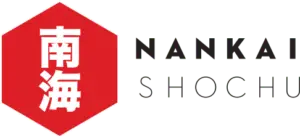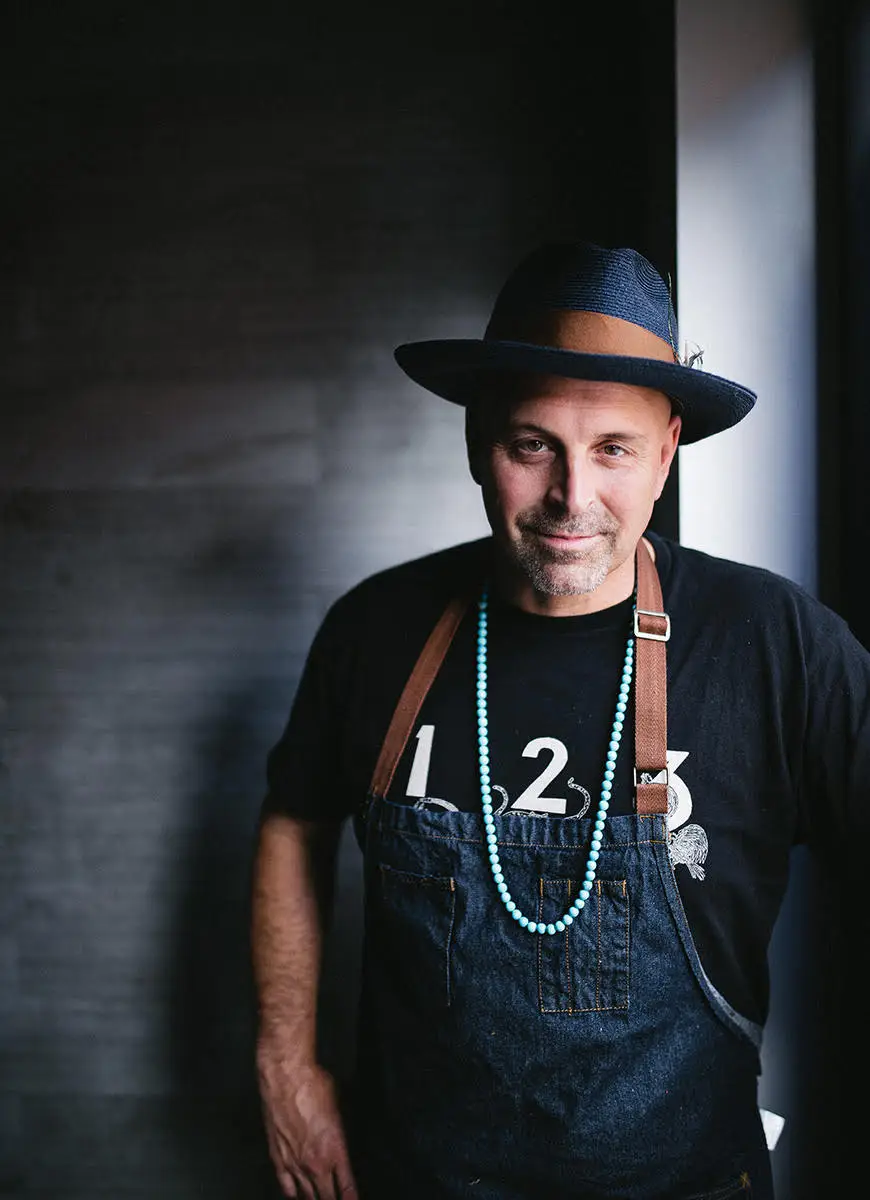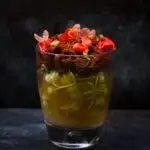If you’re into cocktails, you’ve probably heard of Matthew Biancaniello. After his game-changing start in 2008 at the Roosevelt Hotel’s Library Bar in Hollywood, he’s earned a strong following for infusing food into alcohol and vice versa. His many roles since include being an author, a television host, and, of course, a sought after cocktail consultant.
I first met Matthew Biancaniello at his cocktail pop-up at Ysabel in Hollywood in 2018. Some mutual friends suggested his name as someone that might make some great cocktails with Nankai. That would turn out to be as incredible an understatement as the cocktails that Matthew would later craft for us.

At the pop-up, people lined up around Matthew’s station, eager to get a cocktail, and I began to get a sense of his celebrity. I remember holding a bottle of Nankai Shochu in my hand and debating whether he’d even have time to try it. Staying was the one of the key moments in Nankai’s history, as it was the start of a beautiful friendship with Matthew.
Matthew Biancaniello became a staunch supporter of our products. He crafted a number of drinks for us at a Japanese Consulate shochu event. He even agreed to include Nankai as part of his omakase service at his cocktail venue, Mon-Li. Our distillery partner embraced our marketing strategies shortly after tasting his Nankai cocktails firsthand.
In October 2018, Mon-Li opened in Malibu, California, to rave reviews. His twelve-seat bar was fully reserved and packed that whole month. Almost exactly a month later, the devastating Woolsey Fires would burn most of it to the ground.
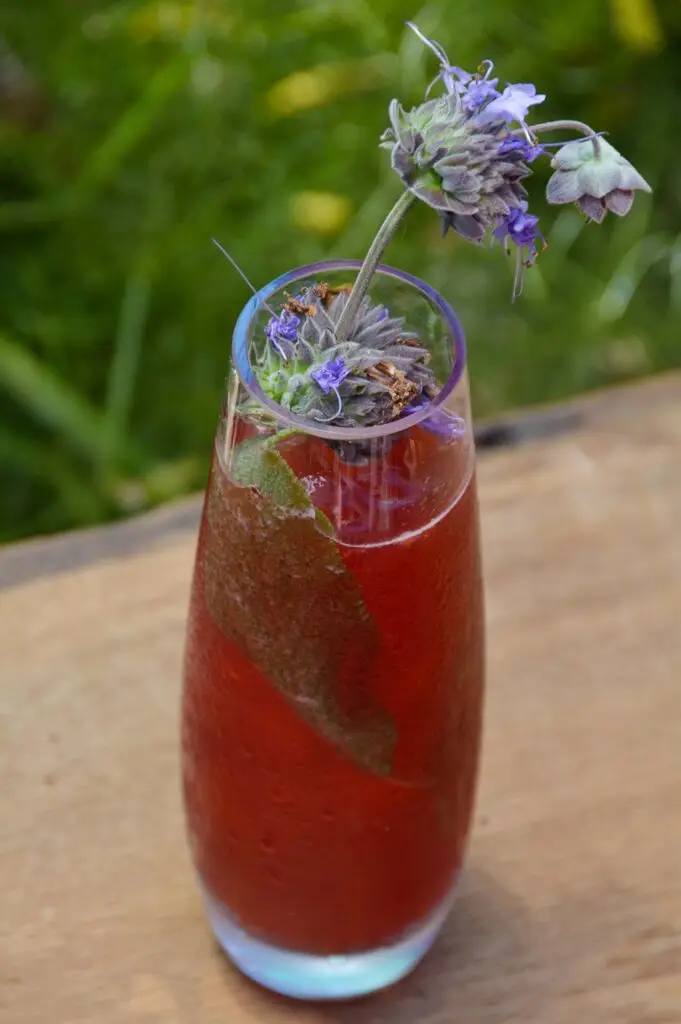
available at matthewbiancaniello.com
But there’s a reason why Matthew’s Instagram posts were often tagged with #thephoenixhasrisen. After taking a few months off to contemplate, Matthew quickly became busy with popular pop-ups, a new book, and preparations to open new venues in Tokyo and Texas.
Then, of course, a global pandemic struck and shut most businesses down, but thanks to Mon-Li, Matthew had learned to be adaptive. He quickly launched a popular and lucrative cocktail delivery business. We sat down to catch up via Zoom to talk about his new ventures and his upcoming cocktail book, Omakocktail.
Business during COVID
Nankai: How have you been, Matthew? It’s crazy with COVID out there.
Matthew Biancaniello: Everything’s good now. It’s been a lot of ups and downs. But I’ve been doing my bottling the whole time.
Nankai: Yeah, tell me about that. How has this pandemic changed your approach to things?
Matthew Biancaniello: I was always somebody where what I do every day was different. Like more of an artist or a creator mindset. And I think one of the things about Corona was I had to learn how to be a grinder. And that’s me in my kitchen making bottled cocktails, which can be a little monotonous. But I’ve developed this new skill and discipline and passion while I’m still creating. And you really get into this sort of peasant mindset, which is, “Shit. I don’t have enough [ingredients] to finish this bottle. Now what?” And then you’re mixing with something else and all of a sudden you’re developing these new creations.
Nankai: Lemons into lemonade.
Matthew Biancaniello: Yeah, the bottling business has been insane. Last week was 52 bottles.
Nankai: That’s crazy. You’re basically a distillery.
Matthew Biancaniello: Yeah, and actually, one of the silver linings of this whole thing has been a chance to become an owner. I’m partnering with an old friend of mine on this bourbon company. We’ve got some barrels, so at the bare minimum, I’ll do infusions and cocktails, so that’s huge.
Nankai: I’m so happy to hear all these great things are happening. It’s been pretty slow for a lot of people, but you’ve really been active.
Matthew Biancaniello: Yeah, it’s a blessing. I’m also consulting for Akasha and helping them with their bottle program. I was supposed to do this place in Newport Beach before, but they didn’t seem to care about the corona virus too much. I’ve done three private parties during Corona, two for 20 people and one for 40. My God. I was pretty safe and protected, but I saw people… it’s the reason why the numbers are this way. People don’t get it unless it’s close to home.
Nankai: Scary times. You mentioned your brother got Corona and was in a coma and a ventilator for months. And then rehab, right?
Matthew Biancaniello: Yeah, it’s unbelievable. So it’s been profound because I’ve gone through almost everything that you could go through during this virus.
Nankai: I’m always amazed by your resilience. First there was the Woolsey Fire…
Matthew Biancaniello: You were there, Paul. You know Mon-Li was such a personal thing. I didn’t even get my feet wet with what I was going to do there. The fire came one month after we opened. You know, I was in a shock, a coma, and I didn’t do anything for three months after that. But when Corona happened, because of what happened at Mon-Li, I didn’t even hesitate. I didn’t care about if it was illegal. I didn’t care about anything. The next day I was making bottles and within two weeks I had five hundred bottles and labels ready to go.
Nankai: It’s amazing how things connect together. But, I was wondering, how did you grow your new business to the point that you were selling so many bottled cocktails per week?
Matthew Biancaniello: I think a couple of things. I do have a following. The thing that’s always interesting about that, and it’s a good lesson for everybody is that you can never take for granted every single person you’ve ever touched. Just because they’re not liking your stuff or commenting, or just because you don’t hear from them, it doesn’t mean that you’re not on their radar. I remember the first week there was someone in San Diego. I told them it’s going to cost $75 for me to drive down there. And they were like, “Okay.” I asked them how they knew me, and they mentioned an event that I had done four years ago. Four years ago!
Nankai: Wow, and living in San Diego, they probably couldn’t do a drive to a pop-up in LA, but delivery opens up a chance to drink your cocktails again.
Matthew Biancaniello: And I’m pretty good at following up. I used to be in sales so I know. I keep everything on Instagram. Don’t text me and don’t e-mail me because it’s all over the place. If you send me a message through Instagram, everything is there in one place. Right? So I can go back to anybody who was interested, not interested and then figure out an order. I did one email and a post, and that was it.
Nankai: It sounds like this is just the start of something really big.
Matthew Biancaniello: Now granted I always could sell more, but right now I can’t handle it. Each bottle is 6-7 drinks. So that’s 350 drinks… I didn’t shake them all, but there’s some weeks where I shook 220 drinks and my arm is killing me. But you know moving moving forward I’ve got to figure this out right because I don’t think this is going away. I don’t. But the bottling has been very successful, so I really can’t complain. I’m grateful.
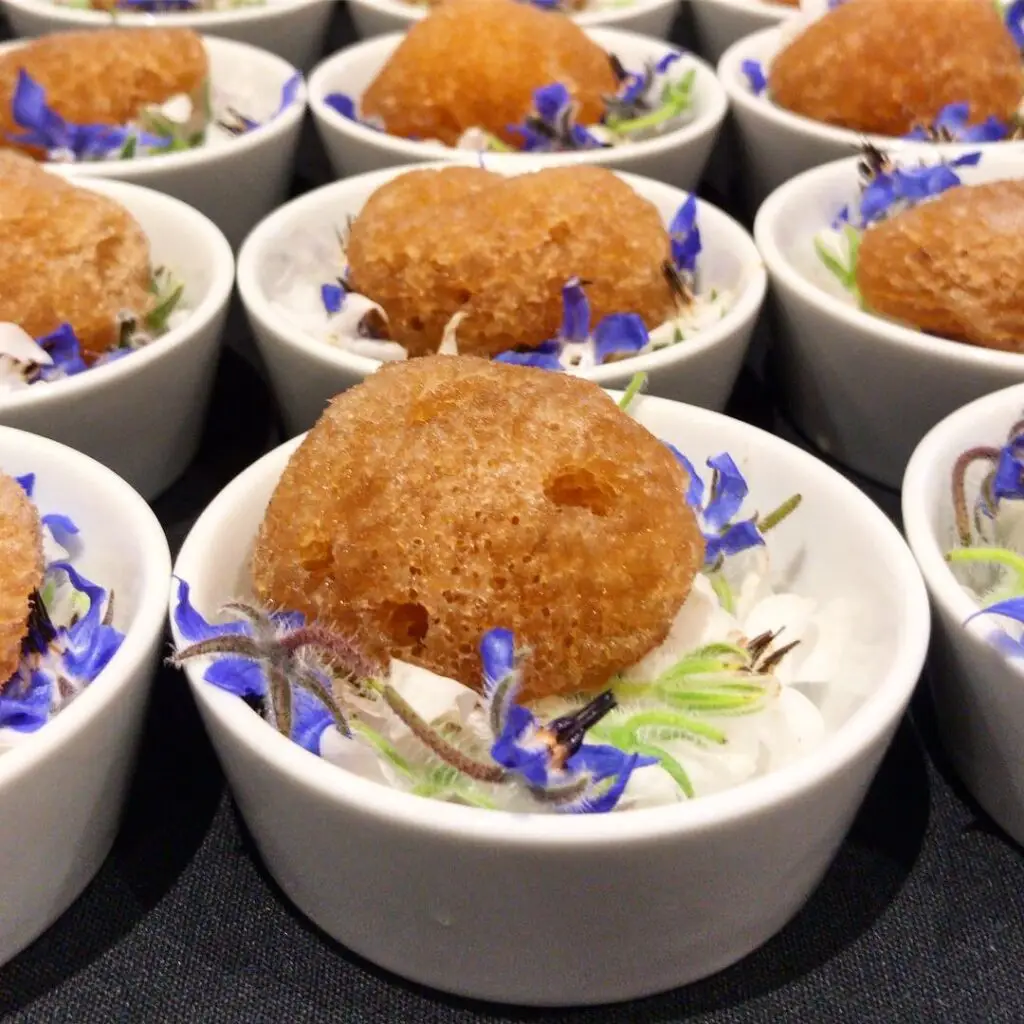
A Commitment to Service
Nankai: This is a great story about finding your audience, especially during a crisis. But I also think it’s an innate ability you might have. I remember the great time that my wife and I had at Mon-Li, and seeing you engage with all of your customers. You seem to have this ability to meet a person and talk with them for a few seconds and just kind of understand the type of drink or the category of drink they might be looking for.
Matthew Biancaniello: I do have that to an extent, but I’m also I’m listening to things, too. I think that it’s more than just about sweet, exotic, or spicy. Is this your first drink of the day? Did you eat already? Do you want a dessert? What time of day? I think people don’t pay enough attention to that sort of stuff. They just they go, “Here’s a drink!” Because you could have a great drink, but, say, if someone’s full, it’s not perfect for them. A digestif might be better right?
Nankai: How did you develop this approach to serving drinks?
Matthew Biancaniello: I’m very very fortunate for my experiences that I had at the Hollywood Roosevelt, not having a cocktail menu and riffing for four and a half years. That’s how I developed my style, and that’s how I developed constantly — interacting with people. The thing is, don’t get me wrong, I wasn’t always right with people.
Nankai: What do you mean? Like, I know sometimes you’ll remake a drink or hand a customer another drink if you don’t sense that they love it.
Matthew Biancaniello: Yes, exactly. Here’s a perfect example. There was a woman years ago at the Library Bar, and I made her this drink. She said, “Oh my God, this is great!” So then I made her another drink and she just went, “Ehh.” Another drink, she went, “Ehh,” and I’m like, “OK listen, I’m pretty upset right now. It’s not you. It’s just I’m upset that I can’t please you right now. I need to go take a walk. I’ll be right back.” She goes, “It’s not that serious.” I said, “It is to me,” so I took a walk.
I went all the way down into the basement, into the freezer, thinking about what the hell her first drink was. This light bulb went off. I went upstairs and made her something. She said, “Now that’s a drink!” See, if it didn’t have ginger in it, she didn’t like it!
Nankai: Wow what?
Matthew Biancaniello: Everyone is different. You’re constantly learning about people, especially with what I do. I don’t think people realize how service oriented I am and how much I am about the individual because of the Library Bar, because of being in that intimate space. In a restaurant, you’re having the wait staff take your drink right? You’re not looking at the customer’s reaction, you know? The waiter or waitress may not be hearing the honest feedback. You ask, “How was that?” And they’ll just say, “Oh good. Great.” But they’re not looking to read people’s faces— they’ve got too many other things to do.
Nankai: The kind of service mindset you’re talking about is like a sommelier.
Matthew Biancaniello: Or like a chef. There used to be this sommelier that used to be at Melisse. He would always bring these little things to try, and he was engaging people. That’s all he’s doing is engaging people. And that’s why a lot of times when people consult me, I’m like, listen, anybody can learn recipes. Anybody. But you need to engage people, and you need to create be creative on your own, which is very simple. It’s just a habit you need to learn. It’s not that you don’t have it. It’s just a habit you need to learn. That’s it.
Nankai: You were at the forefront of the beginning of craft mixology. How did you convince people to try your take on drinks?
Matthew Biancaniello: You know, one of the ways I developed my style, the Library Bar was next to this club called Teddy’s. It was really a lot of young kids drinking vodka red bull. If I’m going to get them to drink my drinks I have to make something that they’re already aware of but elevated. So, it was the dirty martini, the long iced tea and the Bloody Mary. I made my versions of those because if they loved them, they’ll trust anything I did. And that was true.
Nankai: And you’re a highly sought after cocktail consultant, so is that part of what you advise?
Matthew Biancaniello: You know, I always stress this when the client says, “We need these drinks.” I’m, like, forget about the drinks. First of all, they should be creating drinks with me and then they’ll have a menu and actually understand how I did it. Then the value is beyond “You got these drinks.”
“Eat Your Drink” – Culinary Cocktails
Nankai: People often describe your drinks or your style of drinks as “culinary cocktails.” Your instagram handle is, of course, “Eat Your Drink,” but how would you describe your style and approach to cocktails?
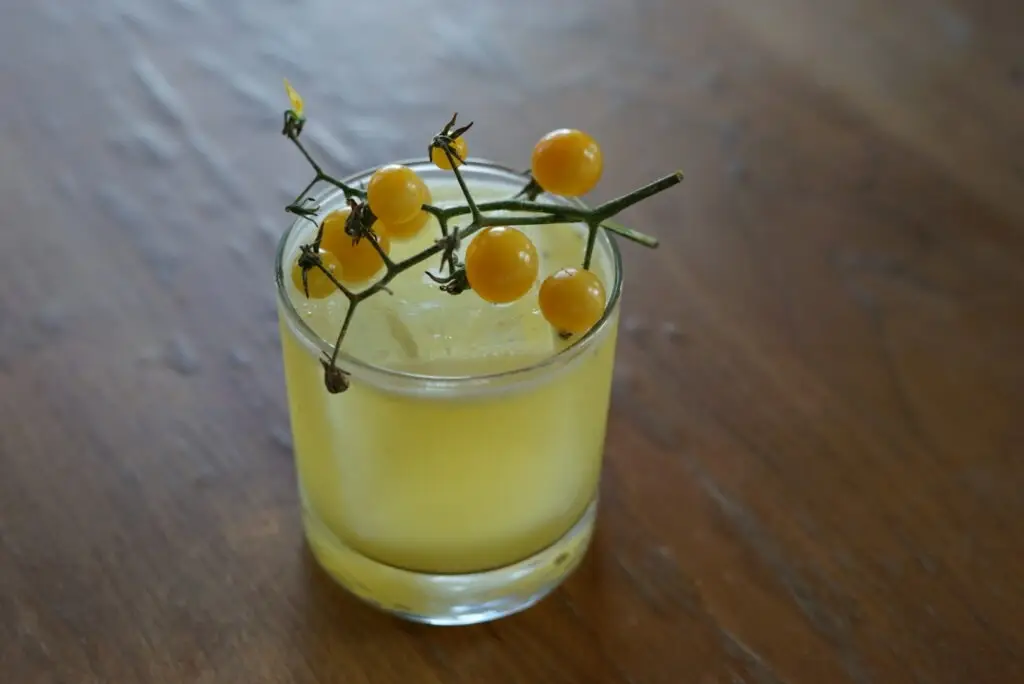
Matthew Biancaniello: I think that’s a hard thing to explain sometimes. A lot of times people don’t know, even if somebody is telling them, until they experience it. And I think for me, my style is fusing the food and alcohol world together using seasonal and unusual ingredients. I mean that’s the best way I can explain myself. I’m totally self-taught. There’s a thousand bartenders out there who have better technique than I do. They have more knowledge in certain things, and I’m much more ingredient-focused than booze-focused.
Nankai: Right, you’re not a hard drinker.
Matthew Biancaniello: You know, I don’t drink that much, but I do appreciate alcohol and appreciate the flavors. And that’s something I really had to develop at the Roosevelt. I remember thinking that I don’t like half this shit but I had to educate myself. And that’s another funny thing. I don’t make drinks necessarily that I would drink. And, I really think more about drinks that other people would like. You, know I might not even like one of these drinks but it’s one of my best sellers. But I developed the capacity to taste in my head. I know exactly how that’s going to taste, well, maybe not always, but generally.
Nankai: Where do you think this came from?
Matthew Biancaniello: My mom was a huge interior designer in Boston. So, I think I get a lot of the artistic part of that from her, which is very important to me. But the thing is, unconsciously, for the first year and a half, I really was rescripting my relationship to alcohol. I was really making it something that was beautiful and something that you sipped and not something that was negative or destructive. And I think I always had that with me. I didn’t drink in high school, and I didn’t event try drugs until I was twenty-three years old. I think when you grow up with a parent that has abused alcohol, you tend to think it’s disgusting in a way. You can go the other way too— Don’t get me wrong.
Nankai: Much of my life until my late twenties I was the same way.
Matthew Biancaniello: I think it was such a turnoff for me, and I also isolated myself because I didn’t want to go to parties that people were drinking at. It was that dramatic. But it also goes maybe deeper than that. Like I remember I always wanted to be a chef.
But the other side of that is I really battled a pretty bad binge eating disorder. And I knew deep down it wasn’t safe to be around food. So when the booze thing came up and I just needed a job, it was perfect. This huge passion came out of me. The things that I loved about cooking and all these fresh ingredients and my grandparents’ garden. I was able to express the culinary side of me that was probably inside me all along in the alcohol because I didn’t care about alcohol. So it was safe to be around it. I could create all day long. It was very profound for me in that way too.
Nankai: That’s incredible. You know I remember in the Ologies podcast you did that you talked about that and it struck a note with me.
Matthew Biancaniello: You heal things once you realize for the most part when you have an awareness like that. So when you’re aware of something, that’s when you can heal. So that happened and then that’s what got me into cooking, like at Mon-Li and my next thing in Dallas. I really have the alcohol and the cocktails to thank for allowing me to do food now.
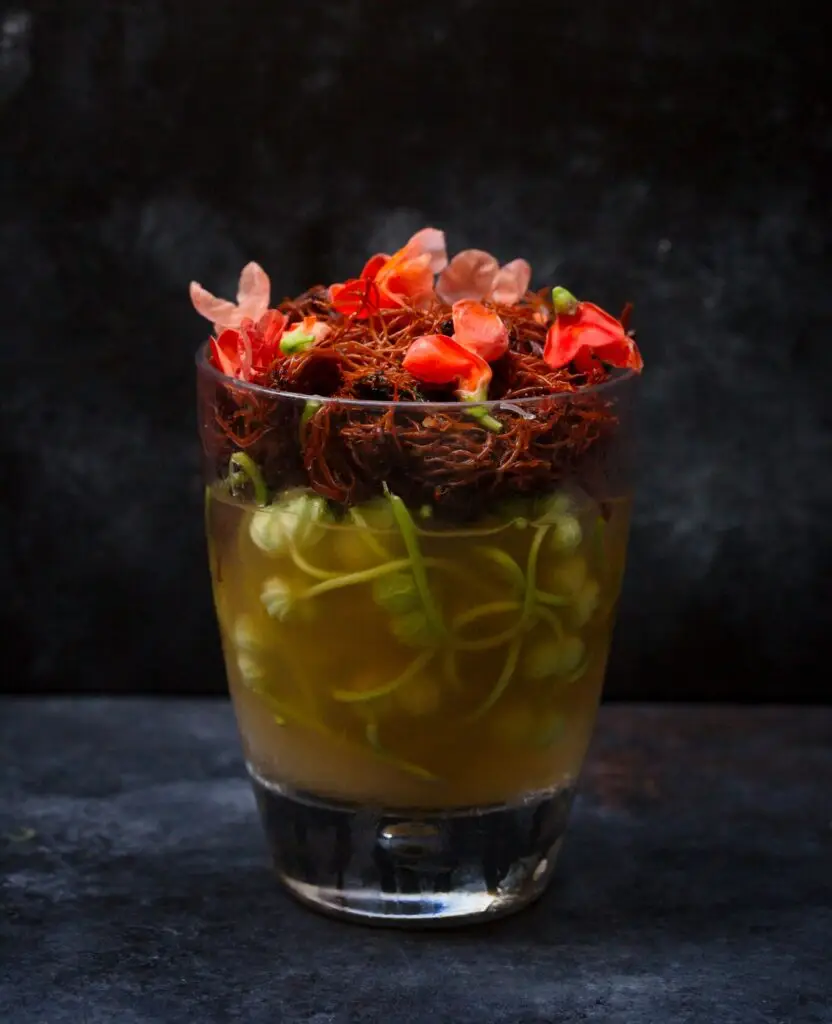
Recipe at the end of the interview. (Photo by Carolina Korman)
The Start of Culinary Cocktails
Nankai: That’s really something, especially when you think about how getting your first job as a bartender now seems kind of fateful.
Matthew Biancaniello: I was 40 years old is when I started at the Roosevelt. To be 40 and never have worked in a restaurant is pretty awesome. But the only reason why I got that job is I knew the manager through yoga. She was friends with my ex-wife. She offered me a bar-back job and I said no way. The next year, she said she had a small quiet room I could work, but I didn’t have any experience. I remember my first night, ducking down and asking the bartender, “What’s in a cosmopolitan?” But it wasn’t long. I saw that menu and that the drinks were not worth 15 dollars. So, I started replacing them with farmers market ingredients. I remember my manager was blown away and offered to start reimbursing me a hundred dollars. I was spending four hundred a week. And I spent eight thousand dollars out of my own pocket, educating myself on ingredients and alcohols and ice. These were all these things that a hotel didn’t care about at the time. And within a year I was in the New York Times, L.A. Times and CNN. It was really really crazy.
Nankai: That is crazy, though. You were spending so much of your own money. But boy did it pay off.
Matthew Biancaniello: And in retrospect, I see why that happened. It wasn’t so much that I was looking for a void in the market and filled it. It was more like this was my passion. I cared about the ingredients and nobody else did. Everyone was doing classic cocktails right because it was really the beginning of Sammy Ross training all the bartenders at Comme Ça. And those people branching out but really sticking with classics. Who knows? People could have been laughing at me for a while.
Nankai: Classic cocktails or reinterpreting classic cocktails was very New York whereas California was more on the kind of farm-to-table side of things. And you were definitely the forefront in that right. What’s your take on on classic cocktails? Did you study them?
Matthew Biancaniello: I did study them obviously when I started. Classic cocktails are a very important part of the culture. But it is such a short period of our culture. What I do like is that is the Sazerac was one of the first contributions to this culture of cocktails way back in the late 1800s. And I think what’s fascinating about about cocktails is around the globe we’ve taken other food, cultures and influences. But the cocktail was really America’s true culinary contribution to the world. And it was when there was Prohibition and those bartenders had to go elsewhere in Europe.
There’s a lot of classics that I love, and I had to do them well, like Manhattans. But then, for example, I can make a shiitake Manhattan. The classics gave me the freedom to reinvent those but in my way. And I think when you say New York and California, we just have access to these things. In New York, yes they can get a lot of produce but it’s not the same. Like the Union Square farmers market, I remember because I lived close to that. After a while you’re just getting apple cider, donuts, cheese, and chicken.
Nankai: What’s your favorite classic cocktail?
Matthew Biancaniello: I still love making Old Fashioneds and Manhattans. I make a Pimm’s Cup from scratch. The Caipirinha is one of my favorite cocktails, and actually, that’s an important thing. The daiquiri is what I base most of my cocktails on. So when I first learned about the daiquiri, I said, “Wait a sec.” A huge light bulb went off. This is rum, lime, sugar. If I take out the rum and put in tequila, it’s a margarita. Right? If I take out the rum and put in a gin, it’s a gimlet. If I put a mint, it’s a mojito.
So the daiquiri, being one of these long time classic cocktails from Cuba, became the template for somebody like me, who was untrained. That’s what most of my drinks were based on and still in a lot of ways based on that format. But what happened was, my passion was so strong. I’m educating myself constantly. And I’ve going to the farmer’s market for 11 years straight, never really missing a week. And that’s a lot of experience and knowledge that is constantly being filtered into my cocktails.
Nankai: You must be pretty famous at the farmer’s market now. It’s like your sandbox.
Matthew Biancaniello: Yeah, you’re right. It gets that way for sure. You gotta remember, too, with what I do, my relationships are stronger with chefs than they are with bartenders. You know, they’re just more my peers and my kindred. So I love when I walk around with chefs, and we’d all be like, “What are you going to do with that?”
Nankai: I do love that your cocktails are more of a culinary theme. It makes it so much fun to riff with you on ingredients. Weren’t you planning something where the food and drinks are swapped?
Matthew Biancaniello: Oh you mean when I wanted to switch where the food was vegetarian and the drinks are meat-based. I think when I open in Dallas, one of the first two concepts will be that and the other will be with the California kelp forests. So I’m gonna be based on that that would be my first tasting menu when I open. That’s why I love when we work together and you have got me those fins from the blowfish.
“The Daiquiri Had My Back.”
Nankai: Oh yeah, you made the blowfish fin infused-cocktail for the Japanese consulate event.That was an incredible drink. How has your approach to making cocktails changed over the years?
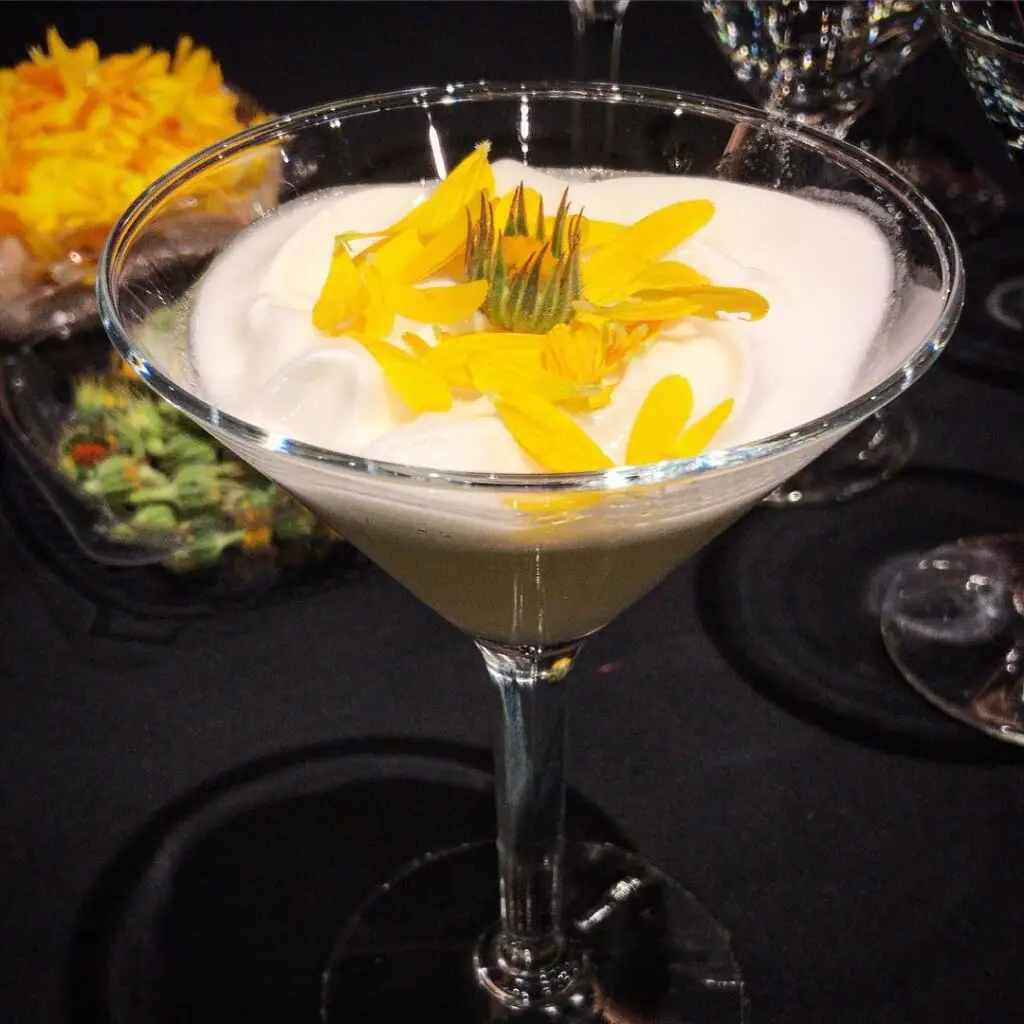
Matthew Biancaniello: It’s a great question. I think if anything, my original style and everything is still there. I think it’s just deepened. Having the addition of food and thinking about food pairing with each drink. And I think we used to be only about the local. Everything was local, local, local right? And if it was out of season, I wouldn’t use it. But I think when I did this show with A&E where I traveled to 10 different countries, I learned about so many interesting incredible ingredients across the globe. I started to be open to fusing the global with the local.
That was one of the most dramatic things that has changed for me is that I will use ingredients like the blowfish fins or sea moss from St. Lucia or things like that. I will use things that are not necessarily in my terroir here. But I love bringing those worlds together. That’s what I love about doing pop-ups in different states or different countries because I’m bringing infusions in my suitcase to pair with whatever I’m finding locally there
Nankai: Were you ever influenced by anyone?
Matthew Biancaniello: I just never wanted to be too influenced by people. It’s why don’t go to a lot of bars and I just don’t want to be influenced. But I think I’m just getting to that point where I’m starting to re-educate and go back. There’s a lot of things if you just see them, you don’t have to recreate them. But, a lot of that global thinking started with this chef, Roberto Cortez, who I did three or four incredible tasting menus with. He’s this amazing chef based in El Paso. He really deals with concepts. I remember when he was cooking, I was like, “Wow, he just he flew that in from there? He didn’t just catch it here?” I was just so naive [laughs], you know? But I saw that it really allowed him to be more creative. And it gave him more access to more flavors and more experiences. And people love that. People also love to know that this ingredient came from this particular region.
Nankai: Some of your your cocktails are kind of way out there for most people. Most wouldn’t think of pairing certain flavors together and you’re famous for these unconventional flavor pairings. What’s your thoughts on the Flavor Bible and the concept of flavors that go together?
Matthew Biancaniello: It’s a great point because I had done these things so many times before I even heard about the Flavor Bible and I don’t even really go to it that much. I do sometimes, not so much to look at pairing things but to remind myself of ingredients. I love seeing al these ingredients in one place. Where the Flavor Bible is useful for me is seeing where they say, “Don’t pair these things,” because that’s where I started. If it said, “Don’t put lavender with coffee,” like I’m gonna put lavender in coffee. The Flavor Bible became this great challenge for me. So those two things it was like reminding me of the ingredients. And telling me these things you shouldn’t put together.
Nankai: How do you how do you combine those things to make them palatable?
Matthew Biancaniello: When you’re explaining to people what’s in a drink, some would be like, “That doesn’t sound very good.” But then they love it, right? And it’s one of the reasons why I also started doing omakase.
I remember this woman asked for something sweet but not too sweet. I made her this drink. And she said, “Oh my God. That’s one of the best friends I’ve ever had. She was what’s in it?” I told her it’s got gin, strawberries, and balsamic vinegar. And she said, “Oh my god, I hate balsamic vinegar. Can you make me something else?” And this was after she said it was the best drink she ever had. So what I realized is how much people get in their head about ingredients and what they think they don’t like. And guess what? That’s 95% true in the culinary world of eating something that is in its full state. When you start making cocktails, you start changing the state of those ingredients. Now in the liquid form, you actually might like it once you take out that texture and just go on with the pure flavor.
Nankai: That’s really interesting, and I can see how that is true. Is it just about changing the state of the ingredients?
Matthew Biancaniello: My basic philosophy is that everything goes with everything. I truly believe that. It’s really about balance. So when you say that lavender doesn’t go with coffee, it’s about how much coffee and how much lavender. And if you go back to the daiquiri and start with the daiquiri, it’s like an incredible template. I always felt like the daiquiri had my back.
Nankai: That’s a great quote.
Matthew Biancaniello: It’s just like anything else that someone gets good at. Once you have momentum or see how people react there or once you’re working without thinking, you start to feel invincible. You’re not judging yourself or thinking about right or wrong. And that’s one of the biggest silver linings of not being trained. You don’t have that voice in your head of, “ Hey! You can’t do that.”
Nankai: Do you ever get the culinary equivalent of writer’s block and how do you treat it?
Matthew Biancaniello: The goal is to always get to a place where you’re in a relaxed state. So yoga has always been a huge thing for me. Taking walks or doing anything that changes your routine is the key to creativity. You’re not looking for ideas. You’re looking for flow. Get quiet. The quieter you get, the more things come to you. And that’s meditation or yin yoga and walks for me. Give your brain a good clean swipe so you’re able to receive. Swimming is great, too, because it’s one of the few times in a day that you don’t hear anything.
With Nankai Shochu
Nankai: I’m gonna put you on the spot, and you can be totally honest, but what do you think of working with our products, Nankai Shochu and Nankai Gold?
Matthew Biancaniello: Well, first of all, I fell in love with you guys. I love you guys. And let’s start with the regular Nankai. That shochu is one of the smoothest, cleanest, most beautiful things I’ve ever tasted. I love the creaminess of it, the flavor of it. And I think it works really great in cocktails when people don’t really want to have something too boozy. I think it’s great that you guys are kind of educating people to this, and commend you on doing that. But I love it. It’s such a beautiful, clean spirit. And it works well in a lot of things for me. It really is something that’s in the vein of what I do.
…one of the smoothest, cleanest, most beautiful things I’ve ever tasted.
Matthew Biancaniello, on Nankai Shochu
Nankai: Aw, man, thank you so much, Matthew. You know that means a lot to us.
Matthew Biancaniello: And what I love about the Gold is, you know, it’s not a whiskey and it’s not this and it’s not that. So it’s got some of those flavor profiles but then there’s something else going on there and people don’t know what it is. It’s got this really nice fullness and richness with the aging of it, and I love it. I think it’s incredible for Old Fashioneds. I think it’s incredible in that. It’s incredible in cocktails, infusing with mushrooms and other things. Because it’s higher proof I do have more flexibility when it comes to cocktails. But I love all the qualities of it. It’s fantastic. And I can’t wait to really showcase it. You know I really can’t wait till I have a place again where I can really showcase it. What you’ve done is incredible. I’m always for people who are kind of trailblazing a category that is not safe to travel because people don’t know it.
Nankai: Yeah, I mean, it’s a gamble but it’s a lot of fun, too.
Matthew Biancaniello: Of course. And that’s the thing too. At the end of the day life is really about choosing somebody that matters to you, something that will challenge you, that you love, and that you have fun with. Because that’s what keeps you engaged.
Find Matthew’s latest adventures and cocktails on his Instagram and website. You can also get a sneak peek at his next book, Omakocktails, with an amazing Nankai cocktail recipe featured in the book and below.
Ogo Seaweed Nankai Gold
Equipment
- Large 2L+ Jar with Cover
- Cocktail Shaker
Ingredients
Ogo Seaweed-infused Nankai Gold
- 750 ml Nankai Gold 1 bottle
- 4 cups Ogo Seaweed 500-512g
Seaweed Salad Garnish
- ½ cup Ogo Seaweed Soaked in water to hydrate
- 1 tbsp Rice Vinegar
- ½ tbsp Olive Oil
- ½ tsp White Miso
- 5 pcs Pea Blossoms
Cocktail
- 2 oz Ogo-infused Nankai Gold
- ¾ oz Lime Juice
- ¾ oz Agave Syrup 1:1 water to agave
- 5 pcs Surinam Cherries
- 5 leaves Lemon Verbena
Instructions
Ogo Seaweed-Infused Nankai Gold
- Add 4 cups ogo seaweed and 1 750ml bottle Nankai Gold to 2L jar.
- Infuse for 10 days.
- Strain Nankai Gold back into bottle.
Seaweed Salad (Garnish)
- Combine rice vinegar, olive oil, and miso. Mix well.
- Add ½ cup ogo seaweed to dressing and toss.
- Top with pea blossoms.
Cocktail
- Muddle lime juice, agave syrup, surinam cherries, and lemon verbena leaves in shaker.
- Add ogo-infused Nankai Gold and ice to shaker. Shake vigorously.
- Strain into rocks glass with ice.
- Garnish with seaweed salad.
